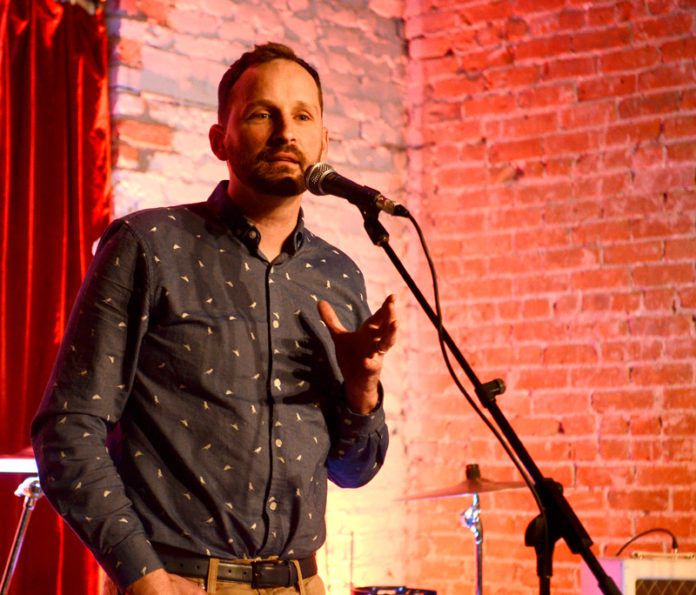
While Monday’s quarterly budget update shows some growth among key economic indicators, the leader of the province’s official opposition is concerned about some of the other results included in the report.
The budget update showed a lower-than-expected forecasted deficit, mostly due to oil and potash prices about $10 higher than originally projected when the budget was written. The province also benefitted from better-than-expected results from SaskPower.
But despite the higher government revenue and GDP growth for the first time in a few years, there are some troubling signs, Ryan Meili said.
Meili, the leader of the Saskatchewan NDP, was in Prince Albert for the annual general meeting of five nearby ridings, held Wednesday evening. He also met with Homeward Bound and stopped by the Daily Herald office for an interview.
He pointed to the $20 million projected increase in spending in both health and social services that the economic situation for many citizens is still not good.
“We’re seeing increases in health and social services, which is interesting because in social services they cut the rental housing supplement,” he said.
“What that says to me is, once again, you’ve got more people needing social services, more people living in poverty and more people needing health services. It’s not surprising to see those two things going up at once.”
The government’s report said the increase in social services was due to increased caseload for child and family services, while the $20 million rise in health costs was caused by increased usage across the health care system.
“That to me is a better indicator of what’s going on in the real economy,” Meili said.
‘There are the resource revenue prices from one industry, but the rest of the economy around the province continues to struggle. More people are out of work, businesses are shutting down and certainly in this area, we’re seeing a lot more economic challenges, and that means more people needing social services, more mental health problems, more downstream effects of an economy that’s struggling.”
Meilli also took issue with the province’s ranking across a variety of economic indicators. While the hard numbers of those indicators were improving, including construction, employment and wages, the province continues to rank below the bottom of Canada’s ten provinces across many of those categories. One exception to that is the Consumer Price Index (CPI), which is used to measure inflation, or price increases. Saskatchewan has the highest CPI increase amongst Canada’s provinces. Saskatchewan is also second in manufacturing sales growth, and fifth lowest in unemployment rate.
“We were ninth or 10th of 10 provinces in seven (indicators) and in the bottom half on pretty much all of them — and some pretty big areas like wages, employment rates and quite noticeably, construction. People aren’t able to build. That’s a sign things are continuing to be really slow,” Meili said.
“Things are costing more and people are earning less. It’s not a great look. The Sask. Party tried to put a sunny disposition on the economy, but when you actually are in the community, we’re hearing that real people are hurting from an economic point of view.”
While Gross Domestic Product (GDP) grew for the first time in several months, indicating the province is out of a recession, Meili pointed out Saskatchewan’s GDP is predicted to grow slowly.
“I hat to throw water on it, but the predictions for the next year from the major banks still have us growing at the lowest rate of any province. Hopefully, that will turn around. Certainly we don’t want to see the economy struggling.”
Meilie called on the government to acknowledge that cuts to health, education and social services, as well as the addition of PST on construction and restaurants, have slowed the economy down.
“They really need to take some responsibility and say what they are going to do to stimulate reform and stimulate the economy in the province.”
Business optimism up
Saskatchewan got more positive economic news Thursday. According to the Canadian Federation of Independent Business (CFIB), small business optimism in Saskatchewan went up in August for the second consecutive month.
In a press release, the CFIB said its monthly business barometer shows optimism is up from 50 in July in 57.9 in August but is still slightly below the 61.6 national average.
“Optimism among Saskatchewan’s small firms kicked into high gear. The index went from gaining 5 points in July to topping up another 8 points in August. The index shows confidence among Saskatchewan’s entrepreneurs to be closer to levels seen in Ontario and New Brunswick,” said Marilyn Braun-Pollon, CFIB’s Vice-President, Prairie & Agri-business in the press release.
“However, employment plans for the next three months haven’t seen much of an improvement though with roughly equal shares of business owners looking to hire (13%) as to layoff (11%). The general state of business improved slightly with 38 per cent of respondents saying their businesses are in good shape, versus 17 per cent who see their firms in bad shape.”
Albert and BC were the least optimistic provinces, while PEI and Quebec remained the most confident. Along with Saskatchewan, Newfoundland saw the largest growth in business optimism.
The biggest challenges for Saskatchewan are insufficient domestic demand, a shortage of skilled labour and management skills and time constraints. Major cost pressures include tax, regulatory costs, insurance and wage costs, fuel and energy costs.
The monthly business barometer is based on responses from a random sample of CFIB members as to whether they expect their business’ performance to be stronger in the next year. Findings are accurate plus or minus 3.5 per cent, 19 times out of 20.

